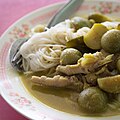 Green curry with chicken, served with roti Green curry with chicken, served with roti | |
| Alternative names | Kaeng khiao wan (native name) Thai cream curry |
|---|---|
| Type | Thai curry |
| Place of origin | Thailand |
| Serving temperature | Hot |
| Main ingredients | |
Green curry (Thai: แกงเขียวหวาน, RTGS: kaeng khiao wan, pronounced [kɛ̄ːŋ kʰǐaw wǎːn], literally "sweet-green curry") is a central Thai variety of curry.
Etymology
The name green curry derives from the color of the dish, which comes from green chilies. The "sweet" in the Thai name (หวาน, wan means 'sweet') refers to the particular color green itself and not to the taste of the curry. As this is a Thai curry based on coconut milk and fresh green chilies, the color comes out creamy mild green or, as this color is called in Thai, 'sweet green' (เขียวหวาน, khiao-wan).
Its ingredients are not exactly fixed. The curry is not necessarily sweeter than other Thai curries, but although the spiciness varies, it tends to be more pungent than the milder red curries. Green curry evolved during the reign of King Rama VI or Rama VII, between the years 1908–1926.
Ingredients
Apart from the main protein, traditionally fish, fish balls, or meat, the other ingredients for the dish consist of coconut milk, green curry paste, palm sugar, and fish sauce. Thai eggplant (aubergine), pea aubergine, basil leaves or other green or whitish vegetables and even fruit are often included.
The consistency of its sauce varies with the amount of coconut milk used. Green curry paste is traditionally made by pounding in a mortar green chillies, shallots, garlic, galangal, lemongrass, kaffir lime leaves, cilantro roots (coriander), and cumin seeds, white peppercorns, shrimp paste and salt.
Cooking method
The paste is fried in split coconut milk until the oil is expressed to release the aromas in the paste. Once the curry paste is cooked, more coconut milk and the remaining ingredients are added, along with a pinch of palm sugar and fish sauce. Finally, as garnishes, Thai basil, fresh kaffir lime leaves, sliced phrik chi faa (the common name means 'sky-pointing chilies', which refers to large mild chilies such as Cayenne pepper) are often used. For a more robust green curry, such as with seafood, julienned krachai (fingerroot or Chinese keys), white turmeric, and holy basil can be used as garnishes.
Serving
Green curry is typically eaten with rice as part of a wider range of dishes in a meal or with round rice noodles known as khanom jeen as a single dish.
Gallery
-
 Ingredients for green curry paste
Ingredients for green curry paste
-
 Freshly made green curry paste in a mortar
Freshly made green curry paste in a mortar
-
 Green chicken feet curry served with khanom jeen
Green chicken feet curry served with khanom jeen
-
 Rice fried with green curry
Rice fried with green curry
-
 Green curry with meat
Green curry with meat
See also
References
- "Easy Thai Green Curry, an Interview with Kasma Loha-unchit". SheSimmers. Archived from the original on 2017-11-27. Retrieved 2014-05-18.
- "Authentic Thai Green Curry Paste, Krueang Kaeng Khiao Wan – Thai Curry Episode II". The High Heel Gourmet.
- ^ David Thompson, Thai Food (edition 2010), Pavilion Books, pages 218-220, ISBN 978-1-86205-514-8
- ^ แกงเขียวหวานเป็ดย่าง [Thai Green Curry with Roasted Duck and Young Chilies]. 2016-10-04. Retrieved 2016-10-04.
- "Easy Green Curry with Pork Recipe". thaifoodandtravel.com.
- Andy Ricker, Pok Pok, Ten Speed Press Berkeley, 2013, pages 161-162, ISBN 978-1-60774-288-3
- "Green curry with fish dumplings, Gang Kiew-wan Pla Grai". chezpim.com. Archived from the original on 2014-05-18. Retrieved 2014-05-18.
- Bush, Austin. "Khanom Jeen! - Austin Bush Photography". Austin Bush Photography. Archived from the original on 2016-07-22. Retrieved 2014-05-18.
External links
 Media related to Green curry at Wikimedia Commons
Media related to Green curry at Wikimedia Commons